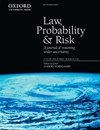Financing EU Public Goods: Vertical Coherence between EU and National Budgets
IF 2.7
4区 社会学
Q1 LAW
引用次数: 0
Abstract
The combination of the challenges emerging from the 2020 pandemic outbreak, amid an unprecedented macroeconomic context, and a limited EU budget, inevitably call for reflections about synergies, or ‘vertical coherence’, between EU and national budgets. The proposals for a larger EU budget, the target of carbon neutrality by 2050, the temporary relaxation of rules for fiscal policy and state aid, would all require greater coordination across government layers. Within this context, this paper studies structural co-movements between EU and national spending over the past two decades, trends that deserve a longer-term assessment, beyond the current response to the pandemic. It finds some synergies, often of a positive sign (leverage rather than substitution), but always very small in magnitude. In light of those results, the paper proposes an “EU public goods rule” for the financing of EU policies, within a commonly agreed and policy-consistent framework.欧盟公共产品融资:欧盟与国家预算的纵向一致性
在前所未有的宏观经济背景下,2020年大流行爆发带来的挑战,加上欧盟预算有限,不可避免地要求反思欧盟和国家预算之间的协同效应,或“垂直一致性”。增加欧盟预算、到2050年实现碳中和的目标、暂时放松财政政策和国家援助规定等提议,都需要政府各层级之间加强协调。在此背景下,本文研究了过去二十年来欧盟和国家支出之间的结构性协同运动,这些趋势值得进行长期评估,而不仅仅是目前对疫情的应对。它发现了一些协同效应,通常是积极的(杠杆而不是替代),但规模总是很小。鉴于这些结果,本文提出了一个“欧盟公共产品规则”,用于欧盟政策的融资,在一个共同同意和政策一致的框架内。
本文章由计算机程序翻译,如有差异,请以英文原文为准。
求助全文
约1分钟内获得全文
求助全文
来源期刊

Law Probability & Risk
MATHEMATICSSTATISTICS & PROBABILITY&-STATISTICS & PROBABILITY
CiteScore
2.10
自引率
28.60%
发文量
8
期刊介绍:
Law, Probability & Risk is a fully refereed journal which publishes papers dealing with topics on the interface of law and probabilistic reasoning. These are interpreted broadly to include aspects relevant to the interpretation of scientific evidence, the assessment of uncertainty and the assessment of risk. The readership includes academic lawyers, mathematicians, statisticians and social scientists with interests in quantitative reasoning.
The primary objective of the journal is to cover issues in law, which have a scientific element, with an emphasis on statistical and probabilistic issues and the assessment of risk.
Examples of topics which may be covered include communications law, computers and the law, environmental law, law and medicine, regulatory law for science and technology, identification problems (such as DNA but including other materials), sampling issues (drugs, computer pornography, fraud), offender profiling, credit scoring, risk assessment, the role of statistics and probability in drafting legislation, the assessment of competing theories of evidence (possibly with a view to forming an optimal combination of them). In addition, a whole new area is emerging in the application of computers to medicine and other safety-critical areas. New legislation is required to define the responsibility of computer experts who develop software for tackling these safety-critical problems.
 求助内容:
求助内容: 应助结果提醒方式:
应助结果提醒方式:


